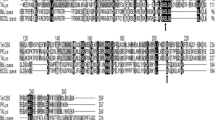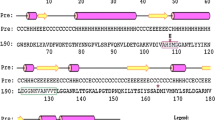Abstract
The gene encoding a cold-adapted, organic solvent stable lipase from a local soil-isolate, mesophilic Staphylococcus epidermidis AT2 was expressed in a prokaryotic system. A two-step purification of AT2 lipase was achieved using butyl sepharose and DEAE sepharose column chromatography. The final recovery and purification fold were 47.09 % and 3.45, respectively. The molecular mass of the purified lipase was estimated to be 43 kDa. AT2 lipase was found to be optimally active at pH 8 and stable at pH 6–9. Interestingly, this enzyme demonstrated remarkable stability at cold temperature (<30 °C) and exhibited optimal activity at a temperature of 25 °C. A significant enhancement of the lipolytic activity was observed in the presence of Ca2+, Tween 60 and Tween 80. Phenylmethylsulfonylfluoride, a well known serine inhibitor did not cause complete inhibition of the enzymatic activity. AT2 lipase exhibited excellent preferences towards long chain triglycerides and natural oils. The lipolytic activity was stimulated by dimethylsulfoxide and diethyl ether, while more than 50 % of its activity was retained in methanol, ethanol, acetone, toluene, and n-hexane. Taken together, AT2 lipase revealed highly attractive biochemical properties especially because of its stability at low temperature and in organic solvents.





Similar content being viewed by others
Abbreviations
- A600 :
-
Absorbance at 600 nm wavelength
- ßME:
-
2-mercaptoethanol
- EDTA:
-
Ethylenediamineteraacetic acid
- DMSO:
-
Dimethylsulfoxide
- DTT:
-
Dithiothreitol
- IPTG:
-
Isopropyl β-d-1thiogalactopyranoside
- OD:
-
Optical density
- PCR:
-
Polymerase chain reaction
- PMSF:
-
Phenylmethylsulfonylfluoride
- PVDF:
-
Polyvinylidene fluoride
- SDS:
-
Sodium dodecyl sulfate polyacrylamide gel electrophoresis
References
Gupta R, Gupta N, Rathi P (2004) Bacterial lipases: an overview of production, purification and biochemical properties. Appl Microbiol Biotechnol 64:763–781
Mosbah H, Sayari A, Mejdoub H, Dhouib H, Gargouri Y (2005) Biochemical and molecular characterization of Staphylococcus xylosus lipase. Biochim Biophys Acta 1723:282–291
Tiesinga JJW, van Pauderoyen G, Nardini M, Ransac S, Dijkstra BW (2007) Structural basis of phospholipase activity of Staphylococcus hyicus lipase. J Mol Biol 371:447–456
Houde A, Kademi A, Leblanc D (2004) Lipases and their industrial applications. Appl Biochem Biotechnol 118:155–170
Hasan F, Shah AA, Hameed A (2006) Industrial applications of microbial lipases. Enzyme Microb Technol 39:235–251
Doukyu N, Ogino H (2010) Organic solvent tolerant enzymes. Biochem Eng J 48:270–282
Joseph B, Ramteke PW, Thomas G (2008) Cold active microbial lipases: some hot issues and recent developments. Biotechnol Adv 26:457–470
Rahman RNZRA, Kamarudin NHA, Yunus J, Salleh AB, Basri M (2010) Expression of an organic solvent stable lipase from Staphylococcus epidermidis AT2. Int J Mol Sci 11:3195–3208
Kwon DY, Rhee JS (1986) A simple and rapid colorimetric method for determination of free fatty acids for lipase assay. J Am Oil Chem Soc 63:89–92
Laemmli UK (1970) Cleavage of structural proteins during the assembly of the head of bacteriophage T4. Nature 227:680–685
Sommer P, Bormann C, Götz F (1997) Genetic and biochemical characterization of a new extracellular lipase from Streptomyces cinnamomeus. Appl Environ Microbiol 63:3553–3560
Nybo K (2012) Troubleshooting forum, molecular biology and techniques: native PAGE. Biotechniques 52:20–21
Arakawa T, Philo JS, Kita Y (2001) Kinetic and thermodynamic analysis of thermal unfolding of recombinant erythropoietin. Biosci Biotechnol Biochem 65:1321–1327
Arakawa T, Philo JS, Ejima D, Tsumoto K, Arisaka F (2006) Aggregation analysis of therapeutic proteins, part 1. General aspects and techniques for assessment. BioProcess Int 4:42–43
Skagerlind P, Folmer B, Jha BK, Svensson M, Holmberg K (1998) In: Lindman B, Ninham BW (eds) The colloid science of lipids, lipase-surfactant interactions. Steinkopff Publisher, Dresden
Laane C, Boeren S, Vos K, Veeger C (1987) Rules for the optimization of biocatalysis in organic solvents. Biotechnol Bioeng 30:81–87
van Oort MG, Deveer AM, Dijkman R, Tjeenk ML, Verheij HM, de Haas GH, Wenzig E, Götz F (1989) Purification and substrate specificity of Staphylococcus hyicus lipase. Biochemistry 28:9278–9285
Oh BC, Kim HK, Lee JK, Kang SC, Oh TK (1999) Staphylococcus haemolyticus lipase: biochemical properties, substrate specificity and gene cloning. FEMS Microbiol Lett 179:385–392
Sakinç T, Klein B, Gattermann GS (2007) Biochemical characterization of the surface-associated lipase of Staphylococcus saprophyticus. FEMS Microbiol Lett 274:335–341
Tyski S, Hryniewicz W, Jeljaszewicz J (1983) Purification of and some properties of the extracellular lipase. Biochim Biophys Acta 749:312–317
Cai Y, Wang L, Liao X, Ding Y, Sun J (2009) Purification and partial characterization of two new cold adapted lipases from Geotrichum sp. SYBC.WU-3. Process Biochem 44:786–790
Simkhada JR, Yoo HY, Cho SS, Choi YH, Kim SW, Park DH, Yoo JC (2012) A novel cold-adapted lipase, LP28, from a mesophilic Streptomyces strain. Bioprocess Biosyst Eng 35:217–225
Feller G (2013) Psychrophilic enzymes: from folding to function and biotechnology. Scientifica 512840. doi:10.1155/2013/512840
Alquati C, De Gioia L, Santarossa G, Alberghina L, Fantucci P, Lotti M (2002) The cold-active lipase of Pseudomonas fragi. Heterologous expression, biochemical characterization and molecular modeling. Eur J Biochem 269:3321–3328
Aghajari N, Feller G, Gerday C, Haser R (1998) Structures of the psychrophilic Alteromonas haloplanctis α-amylase give insights into cold adaptation at a molecular level. Structure 6:1503–1515
Fu J, Leiros H-KS, De Pascale D, Johnson KA, Blencke HM, Landfald B (2013) Functional and structural studies of a novel cold-adapted esterase from an Arctic intertidal metagenomic library. App Microbiol Biotechnol 97:3965–3978
Sayari A, Agrebi N, Jaoua S, Gargouri Y (2001) Biochemical and molecular characterization of Staphylococcus simulans lipase. Biochimie 83:863–871
Simons JW, Adams H, Cox RC, Dekker N, Götz F, Slotboom AJ, Verheij HM (1996) The lipase from Staphylococcus aureus. Expression in Escherichia coli, large-scale purification and comparison of substrate specificity to Staphylococcus hyicus lipase. Eur J Biochem 242:760–769
Andreini C, Bertini I, Cavallaro G, Holliday GL, Thornton JM (2008) Metal ions in biological catalysis: from enzyme databases to general principles. J Biol Inorg Chem 13:1205–1218
van Kampen MD, Rosenstein R, Gotz F, Egmond MR (2001) Cloning, purification and characterisation of Staphylococcus warneri lipase 2. Biochim Biophys Acta 1544:229–241
Tjeenk ML, Bulsink YBM, Slotboom AJ, Verheij HM, de Haas GH, Demleitner G, Götz F (1994) Inactivation of Staphylococcus hyicus lipase by hexadecylsulfonyl fluoride: evidence for an active site serine. Protein Eng 7:579–583
Das AK, Bellizzi JJ III, Tandel S, Bieh E, Clardy J, Hofmann SL (2000) Structural basis for the insensitivity of a serine enzyme (palmitoyl-protein thioesterase) to phenylmethylsulfonyl fluoride. J Biol Chem 275:23847–23851
Mogensen JE, Sehgal P, Otzen DE (2005) Activation, inhibition, and destabilization of Thermomyces lanuginosus lipase by detergents. Biochemistry 44:1719–1730
Delorme V, Dhouib R, Canaan S, Fotiadu F, Carrière F, Cavalier J-F (2011) Effects of surfactants on lipase structure, activity, and inhibition. Pharm Res 28:1831–1842
Chakravorty D, Parameswaran S, Dubey VK, Patra S (2012) Unraveling the rationale behind organic solvent stability of lipases. Appl Biochem Biotechnol 167:439–461
Lousa D, Baptista AM, Soares CM (2013) A molecular perspective on nonaqueous biocatalysis: contribution from simulation studies. Phys Chem Chem Phys 15:13723–13736
Rahman RN, Geok LP, Basri M, Salleh AB (2005) An organic solvent tolerant protease from Pseudomonas aeruginosa strain K. Enzyme Microb Technol 36:749–757
Volpato G, Rodrigues RC, Heck JX, Ayub MAZ (2008) Production of organic solvent tolerant lipase by Staphylococcus caseolyticus EX17 using raw glycerol as substrate. J Chem Tech Biotechnol 83:821–828
Fang Y, Lu Z, Lv F, Bie X, Liu S, Ding Z, Xu W (2006) A newly isolated organic solvent tolerant Staphylococcus saprophyticus M36 produced organic solvent-stable lipase. Curr Microbiol 53:510–515
Esakkiraj P, Rajkumarbharathi M, Palavesam A, Immanuel G (2010) Lipase production by Staphylococcus epidermidis CMST-Pi 1 isolated from the gut of shrimp. Ann Microbiol 60:37–42
Ogino H, Uchiho T, Doukyu N, Yasuda M, Ishimi K, Ishikawa H (2007) Effect of exchange of amino acid residues of the surface region of the PST-01 protease on its organic solvent-stability. Biochem Biophys Res Commun 13:1028–1033
Acknowledgments
We thank Prof Dr. Andrew H.-J Wang and Dr. Lee Cheng-Chung from Institute of Biological Chemistry, Academia Sinica, Taiwan for AUC analysis. This project was supported by Ministry of Science and Technology, Malaysia [02-01-04 SF 1024].
Conflict of interest
The authors declare that there is no conflict of interest.
Author information
Authors and Affiliations
Corresponding author
Rights and permissions
About this article
Cite this article
Kamarudin, N.H.A., Rahman, R.N.Z.R.A., Ali, M.S.M. et al. A New Cold-Adapted, Organic Solvent Stable Lipase from Mesophilic Staphylococcus epidermidis AT2. Protein J 33, 296–307 (2014). https://doi.org/10.1007/s10930-014-9560-3
Published:
Issue Date:
DOI: https://doi.org/10.1007/s10930-014-9560-3




